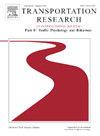2 级自动化对驾驶员行为的影响:关联规则挖掘研究
IF 3.5
2区 工程技术
Q1 PSYCHOLOGY, APPLIED
Transportation Research Part F-Traffic Psychology and Behaviour
Pub Date : 2024-10-30
DOI:10.1016/j.trf.2024.10.016
引用次数: 0
摘要
驾驶员分心和态势感知能力下降对配备二级(L2)自动化系统(如自适应巡航控制系统和车道保持辅助系统)的车辆构成重大风险。本研究利用关联规则挖掘(ARM)分析了自然驾驶数据,以研究二级自动驾驶对驾驶员行为的影响。数据集包括 771 个按 L2 系统激活状态(激活或未激活)、交叉路口类型和手在方向盘上的位置分类的驾驶事件。对关键变量进行了分析,如眼睛离开路面(EOR)时间、离开路面视线的频率和持续时间,以及不同驾驶条件的影响。研究结果表明,当 L2 系统处于激活状态时,驾驶员的分心程度明显更高,表现为 EOR 时间更长、偏离路面的视线更频繁。此外,L2 系统启动时,驾驶员双手不放在方向盘上的注意力不集中程度最高。这些洞察力凸显了改进驾驶员与系统界面的必要性。他们有针对性地开展了驾驶员教育,以提高 L2 自动化的安全性和有效性,最终促进道路更加安全,政策决策更加明智。本文章由计算机程序翻译,如有差异,请以英文原文为准。
Impact of level 2 automation on driver behavior: A study using association rules mining
Driver distraction and reduced situational awareness pose significant risks in vehicles with Level 2 (L2) automation systems, such as adaptive cruise control and lane-keeping assistance. This study analyzed naturalistic driving data using Association Rules Mining (ARM) to investigate the impact of L2 automation on driver behavior. The dataset included 771 driving events categorized by L2 system activation status (active or inactive), intersection types, and hand positions on the steering wheel. Key variables were analyzed, such as eyes-off-road (EOR) time, off-road glance frequency and duration, and the influence of different driving conditions. The findings revealed that driver distraction, indicated by longer EOR times and more frequent off-road glances, is significantly higher when L2 systems are active. Additionally, drivers exhibit the highest levels of inattention with no hands on the wheel during L2 activation. These insights highlighted the need for improved driver-system interfaces. They targeted driver education to enhance the safety and effectiveness of L2 automation, ultimately contributing to safer roadways and better-informed policy decisions.
求助全文
通过发布文献求助,成功后即可免费获取论文全文。
去求助
来源期刊
CiteScore
7.60
自引率
14.60%
发文量
239
审稿时长
71 days
期刊介绍:
Transportation Research Part F: Traffic Psychology and Behaviour focuses on the behavioural and psychological aspects of traffic and transport. The aim of the journal is to enhance theory development, improve the quality of empirical studies and to stimulate the application of research findings in practice. TRF provides a focus and a means of communication for the considerable amount of research activities that are now being carried out in this field. The journal provides a forum for transportation researchers, psychologists, ergonomists, engineers and policy-makers with an interest in traffic and transport psychology.

 求助内容:
求助内容: 应助结果提醒方式:
应助结果提醒方式:


